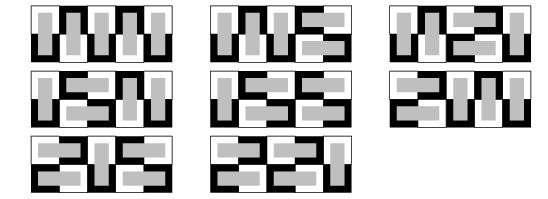A Closed Form for the Fibonacci Sequence
Colin Mitchell
Suppose
that two rabbits are born at ![]() , produce two rabbits at
, produce two rabbits at ![]() , and another two rabbits at each
, and another two rabbits at each ![]() after that. Also suppose that the rabbits never die. If
we let
after that. Also suppose that the rabbits never die. If
we let ![]() denote the number of
pairs of rabbits at time t, then we
know that at months 0 and 1, we have one pair of rabbits. At month 2, these rabbits produce a pair,
which gives us three pairs. At month 3,
we have the original pair, their first off-spring, and another pair created by
the original offspring, which gives us three pairs. At month 4, the original pair have created three pair, and the pair born at month 2 have
created their own, which gives us five pair.
At month 5, the original pair have bore 4 pair, the rabbits born at
month 2 have born two pair, and the rabbits born on month 3 have bore a pair,
so this gives us 8 pairs of rabbits. We
can write this as
denote the number of
pairs of rabbits at time t, then we
know that at months 0 and 1, we have one pair of rabbits. At month 2, these rabbits produce a pair,
which gives us three pairs. At month 3,
we have the original pair, their first off-spring, and another pair created by
the original offspring, which gives us three pairs. At month 4, the original pair have created three pair, and the pair born at month 2 have
created their own, which gives us five pair.
At month 5, the original pair have bore 4 pair, the rabbits born at
month 2 have born two pair, and the rabbits born on month 3 have bore a pair,
so this gives us 8 pairs of rabbits. We
can write this as

and generalize it as
![]() .
.
This is the Fibonacci Sequence. We want a closed form for n. Consider the linear difference equation
![]()
If we set ![]() , we can rearrange this to get
, we can rearrange this to get
![]() ,
,
which is
our Fibonacci Sequence. So if we try the
solution ![]() , we get the characteristic equation
, we get the characteristic equation
![]()
The roots of ![]() are
are ![]() . So we have two roots of multiplicity one. This tells us that our general solution is a
linear combination of these roots, or that
. So we have two roots of multiplicity one. This tells us that our general solution is a
linear combination of these roots, or that

Since we know that ![]() , we get
, we get

So if we set ![]() , this simplifies correctly, and we have our closed form
, this simplifies correctly, and we have our closed form

Now,
let's consider the number of ways that we can align dominoes on a ![]() checkerboard. Using a
checkerboard. Using a ![]() , we get two combinations:
, we get two combinations:

If we consider a ![]() board, we get the
following three distinct combinations:
board, we get the
following three distinct combinations:

Now let's look at the ways we can
combine on a ![]() :
:

Here we get five ways. If we look at a ![]() board, we find that we
get 8 possibilities:
board, we find that we
get 8 possibilities:

We can deduce from this that for
a ![]() checkerboard, we get
the Fibonacci number
checkerboard, we get
the Fibonacci number ![]() , and we could use the closed form derived earlier to find
the combinations for an arbitrary checkerboard.
, and we could use the closed form derived earlier to find
the combinations for an arbitrary checkerboard.